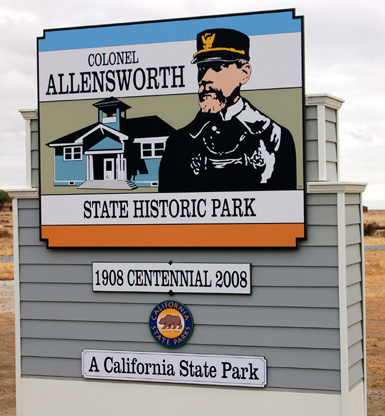
The sign on California Route 46 between Highway 99 and I-5 was small. My GPS said the destination was 18 miles out of my way on the long drive home. But when else might I have a chance to stop by Colonel Allensworth State Historic Park? Here's a little of what I saw...
Colonel Allen Allensworth was born in Louisville, Kentucky into slavery in 1842. Determined to get educated, he left his family and served in the Union Army in the Civil War rising to the rank of chief petty officer. With slavery abolished, he went on to get the education he craved, including a doctorate in theology. He then became chaplain to one of the U.S. Army's four segregated regiments, retiring as a lieutenant colonel in 1906.

Allensworth was an exponent of Booker T. Washington's philosophy that African-Americans should pull themselves up by their bootstraps through self-reliance, education and hard work. Along with Professor William Payne of Pasadena, Allensworth shared a mutual desire to live in an environment where Blacks could be free from discrimination. They formed the California Colonization and Home Promotion Association in 1908 and purchased 800 acres along the Santa Fe railroad line in Tulare Country in California's San Joaquin agricultural heartland. The park brochure reports proudly:
The town quickly attracted residents. But Allensworth died in an accident in 1914, just about the time that it became apparent that settlers faced a severely depleted water supply in an area always arid and made more-so by heavy agricultural development. Residents drifted away -- by 1973 the town no longer appeared on maps.In 1909 the colony of Allensworth began to rise from the flat countryside -- the first town in California founded, financed and governed by Black Americans.
But California African Americans were determined that Allensworth's special history should be preserved: the land was purchased by the state in 1974 and buildings have been restored since. This year the park celebrated the town's centennial.

To a contemporary eye, the restored houses look small -- and very solid.

It's hard to tell whether during Allensworth's heyday, residents enjoyed any protective shade. The Smith house is the only contemporary one surrounded by any trees, including a magnificent Lombardy poplar that dominates the pancake flat landscape.

There was a hotel. Elizabeth Dougherty of Oakland saw a business opportunity, financed its construction and hired John and Clara Morris to manage it. The building was site of community social evenings and dances to music provided by a player piano.

Residents built themselves an elementary school ...

and a Baptist Church which continued to serve a congregation until 1967.

The town had a bakery...

a barber shop marked by a traditional pole ...

and even a sort of "motel" -- this building served as temporary housing for visitors and new residents who had not yet built solid homes.
Allensworth seems a fascinating instance of the deeply ingrained U.S. tradition of people going apart (voluntarily and involuntarily) into not-yet-developed lands to live more freely and as they think rightly; other examples include the 1840s transcendentalist utopia Brook Farm, early Mormon wanderings which resulted in the state of Utah, and such more contemporary examples as The Farm in Summertown, Tennessee. I'm glad the memory of this African American experimental community is preserved as a state historic park.
Former residents certainly seem to have fond memories. Here (transcribed from a park sign) is what Elizabeth Payne McGhee recalled:
We never felt deprived. We didn't have plumbing facilities, we didn't have electricity, there were many things that we didn't have, but we didn't feel the lack of them. We would got to Pasadena in the summer and enjoy all those things in the city, but when we got home we were quite content, because there were always streams to explore, and fish to catch and we took lots of pictures. Women did needlework, lots of crocheting, canning and so forth. And we read and wrote. I remember when I was nine and my sister was eleven and we had started a novel, and we were writing a play, and my eldest sister played the piano. We composed songs. Everyone was creative, because if you don't have it handed out to you, you make your own.
3 comments:
Thank you for an interesting tour of the Historic Park. The yearning to be free is in the hearts of all people. It's too bad that a dearth of water ended the dreams of the residents.
Fascinating! I was familiar with Allensworth but had no idea this existed! Thanks!!!! And as always, I love the photos.
Thanks for highlighting this, Jan. And for further exploration, the recently published book Allensworth: The Freedom Colony by Alice Royal (with Mickey Ellinger and Scott Braley) is outstanding.
Post a Comment